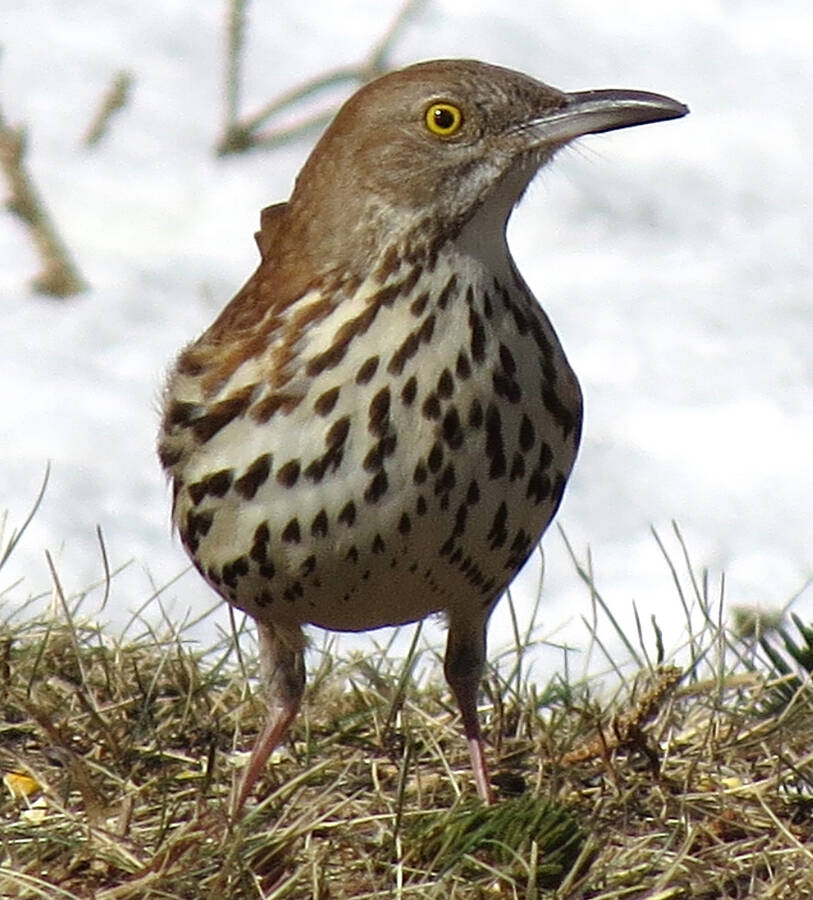
2024-02-28
All about the brown thrasher
I haven't seen a brown thrasher for two years.
So, I was envious when I heard that there was one in Antigonish County, but it was too far for me to be able to travel right now. So when Dorothy Poole sent me a photo of one at West Berlin at the residence of Helen Williamson and Debbie Taylor I was excited.
On Feb. 19, I made a trip there with Wayne Greene and Natalie Barkhouse-Bishop. After we waited about a half hour, the brown thrasher made an appearance and came out into the open giving us wonderful views and photo opportunities. I've seen a number of brown thrashers over the years but, I never get tired of watching them.
The brown thrasher nests from Alberta across Canada to Quebec and down into Maine and east of the Rocky Mountains to Texas, the Gulf Coast and Florida. There are a few records of nesting for Nova Scotia. They winter from Oklahoma east to North Carolina and Maryland and south to Florida.
This bird is 26.25 to 30 cm. long with a wingspread of 31.25 to 35 cm. They are reddish brown above and pale buff to white below. The underparts are heavily streaked. The bill is blackish and rather long and slightly down-curved. There is a long rounded tail and the wings are short with two white bars. The eyes of adults are deep yellow.
The food of the brown thrasher consists of June beetles and grubs, Japanese beetles, rose beetles, cotton-boll weevils, curculios, wireworms, tent caterpillars, gypsy moth caterpillars, grasshoppers, crickets, cankerworms, army worms, cutworms, leafhoppers, treehoppers, cicadas, sow bugs, lizards, snakes, salamanders, tree frogs, blackberries, blueberries, holly berries, elderberries, pokeberries, raspberries, hackberries, and other berries, figs, acorns, waste corn and wheat. They will also feed on seeds.
Another species that was a treat to see at this time of year was a fox sparrow. A number of these birds are showing up much earlier than expected for whatever reason.
Stephen Joudrey of Whynott's Settlement had one arrive and I saw postings of a number of others. One person had two chipping sparrows and a fox sparrow. On Feb. 17, while watching the clay-coloured sparrow at Kissing Bridge Road, I was thrilled to see 13 northern cardinals. There were 10 males and three females. Nearby there were two more males at First Peninsula.
Gary Lohnes of Green Bay noticed a male common merganser. About 20 years ago this was a bird that we rarely saw here. Now we see them year round. Greg Van De Moortele noticed a group of buffleheads feeding near the old bridge in Bridgewater.
There now are numbers of common goldeneyes, common mergansers and other duck species feeding in Bridgewater near Shipyards Landing. During the Great Backyard Bird Count from Feb. 16-19, Greg had two northern cardinals, numbers of dark-eyed juncos, black-capped chickadees, American goldfinches, downy woodpeckers, a mourning dove and song sparrows.
On Feb. 15, Charles Barry of Bridgewater had a female red-winged blackbird. Heather Stewart of LaHave reported a number of American robins. On Feb. 19, Doug Joudrey had three in Bridgewater. Stephen Joudrey of Whynott's Settlement had a couple of purple finches show up. He mentioned that it has been a couple of years since he has seen them over the winter. There seem to be more purple finches than normal for this time of year. I've been seeing them everywhere.
Stephen also has 20 blue jays, 15 mourning doves, a pair of white-throated sparrows, several song sparrows, 12 dark-eyed juncos, six American goldfinches and black-capped chickadees as regulars.
On Feb. 19 John Loch reported a gray catbird along the Kissing Bridge Road. Robert Keereweer noted that the male gadwall still continued at Graves Island. Andrew Bates saw the pink-footed goose at Second Peninsula on Feb. 21.
Glenn Rhodenizer reported a sharp-shinned hawk at Second Peninsula. He also saw a hawk carrying a duck. The only hawk that would hunt ducks and would be able to carry them would be a northern goshawk. This hawk is powerful. While trout fishing, I once saw one of these hawks backstroking to the shore with a mallard in its talons.
Here's how to tell downy and hairy woodpeckers apart. The bill of the downy is a lot shorter than that of the hairy woodpecker. The downy is also much smaller. With the males, the red patch on the back of the head has a split down the middle for the hairy woodpecker. It is solid on the downy woodpecker.
Logan Moore reported the arrival of brant at Cape Sable Island on Feb. 17. On that date the grey heron was reported as still tending at Argyle Head. As of Feb. 21 the king eider was still at Cape Sable Island and the mute swan was still at Pickney's Point, Cook's Beach. A number of American woodcocks have been reported down Yarmouth way.
You may reach me at (902) 693-2174 or email jrhbirder@hotmail.com.






